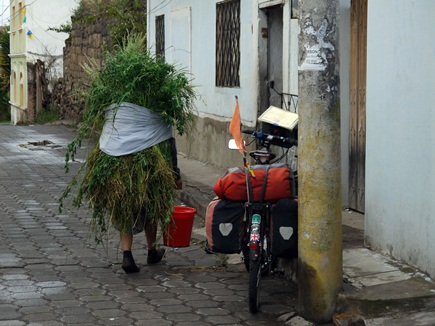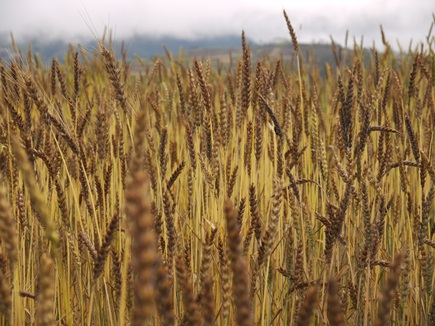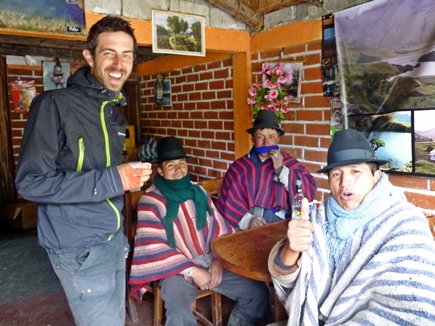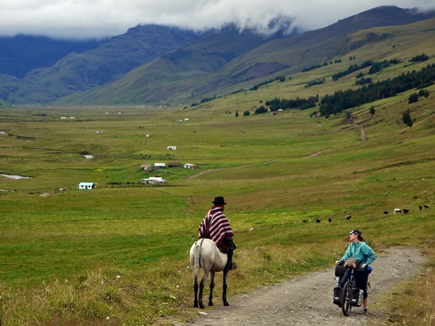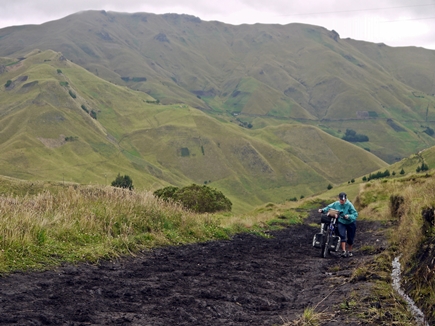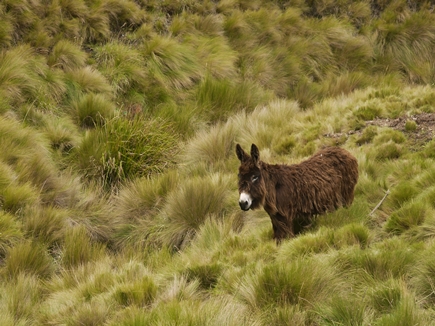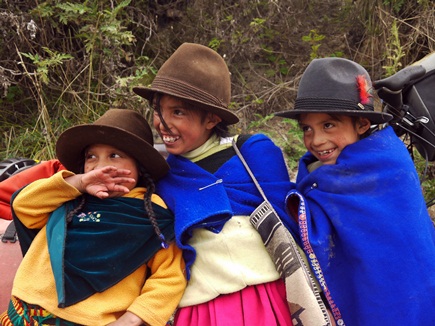Rollercoaster to Riobamba
April 2nd, 2013
There’s something about the first couple of hours riding every morning. For me these are the golden hours, the times when my head is full of freedom and optimism, and I feel like I could just keep riding and exploring forever.
The early morning caffeine has kicked in, and every sense is heightened, on edge. I fill my lungs with clean, crisp mountain air. My legs feel fresh, the fatigue of yesterday’s riding long forgotten. The gradients which had me wobbling to grind out the last few kilometres the day before no longer feel so steep. Even my bike feels lighter – now part of me, rather than just a heavy weight trying to drag me back down each hill. Pedalling seems like the most natural state in the world; the possibilities endless.
This is when the Andean light is at its best; a pure, high altitude light in which colours become more vivid and objects more alive than I’ve ever seen before. An Ecuadorian colour palette: the cobalt blue of the sky and the rich greens of the patchwork fields, broken only by the splashes of red or purple from the shawls of figures high on the hills.
Old men in ponchos grin, and doff their felt hats as we ride past. “Pa’ dónde van?” (“Where are you going?”) they ask, twisting their palm upwards in that questioning latino way. We shout the name of the next village, and they just laugh. “En bici?! Suerte!” (“By bike?! Good luck!”). Pigs on leads run through the streets, driven out to pasture for the day by children wielding sticks. Toothless old ladies suddenly pop up out of the verges, knitting in hand while they watch over their roadside flock of sheep, goats or llamas.
And it is always on backroad rides like this one from Quilotoa to Riobamba that I feel my early morning freedom most intensely. This route was no exception; a real rollercoaster through beautiful valleys, sleepy villages and lively markets – all with a healthy dose of mud and lung-busting Ecuadorian climbs thrown in for good measure.
A big thank you once again to Cass Gilbert for trailblazing this route, and for tempting us off the tarmac and onto the dirt with his account.
James
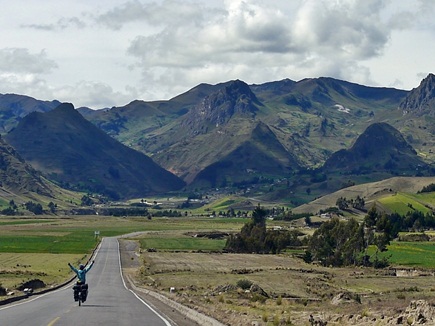
Not many rides in Ecuador start like this: a smooth, fast descent from Quilotoa…

…past more of those classic patchwork fields of green…

..and towards Zumbahua, where we'd visited the market the day before. Today, the town feels sleepy, hungover even – but not enough to stop Sunday League football, which is in full swing against a looming Andean backdrop.

From Zumbahua, we wind our way slowly up on the paved road towards Quevedo, before turning off onto a dirt road across the páramo towards Angamarca – “Nido de Condores”, or “The Condors' Nest”.
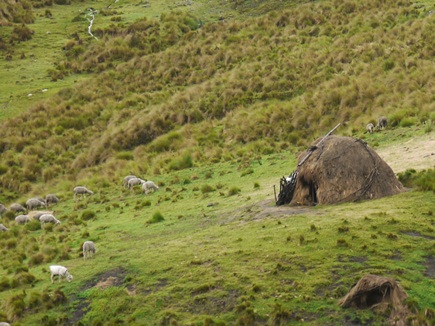
As the road winds its way up past thatched shepherds' huts, the clouds close in, the rain begins to fall and we start to get that cold and wet páramo feeling. A bus driver stops to ask where we are headed. “Angamarca!” we reply. He bursts out laughing, and rolls on.

Eventually we hit the top of the pass and begin a freezing descent, pausing to defrost our fingers and admire this Superpig in his fertiliser bag cape. You know it's wet when even the pigs are wearing their rain gear…
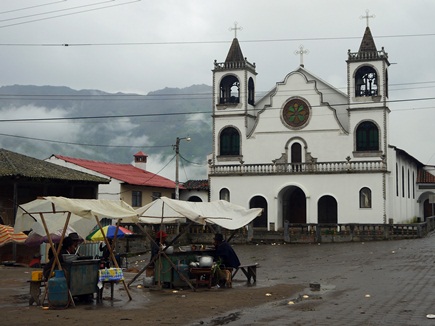
…and we are truly sodden by the time we roll into Angamarca. We get lucky – it turns out the village is home to an Italian mission, and the priest takes pity on the two soggy cyclists asking for permission to camp on his very nicely-tended lawn. Within half an hour we are set up with bunk beds, sipping espresso and tucking into a pasta meal. Grazie mille Padre Bautista e Mario!
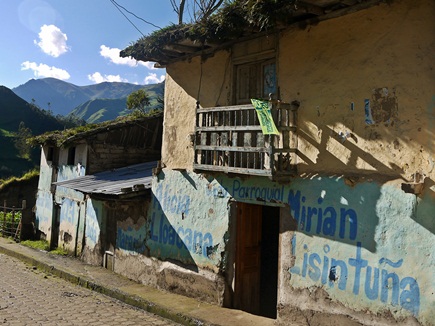
The next morning the sun is shining, revealing Angamarca in all its tumbledown, friendly charm.
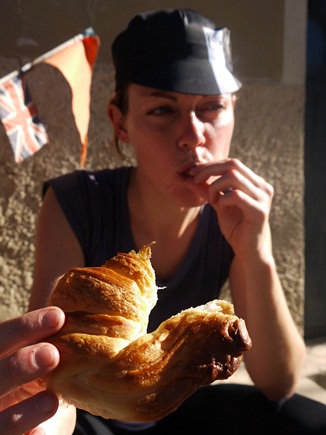
We head for the village bakery to begin our daily search for cheap, filling calories. To our delight, Ecuador seems to have far more sophisticated bakery tastes than Colombia. Baguettes, brown bread that's not sweet, and, best of all… croissants, or cachos as they are known here. We sit in the sunshine and devour a batch fresh out of the oven.
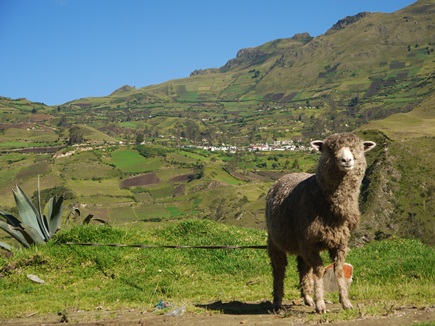
From Angamarca, the Cordillera begins to drop away towards the coast, and we descend – past sheep, cows and goats brought out to the roadside to graze, watched over by young children and old ladies…
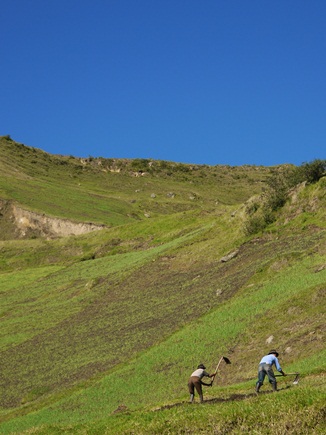
…and past farmers working the impossibly steep fields. Before reaching the town of El Corazón, we turn off in Pinllopata onto a seasonal track which should lead us towards Simiátug.
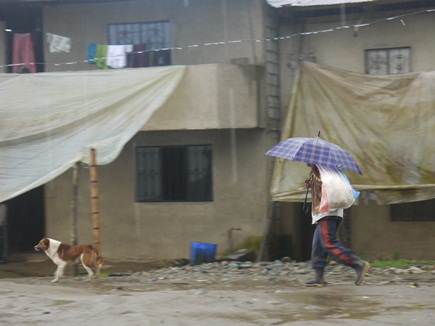
Just as the now regular afternoon deluge begins, we make it to Quishpe, a sorry cluster of houses draped in plastic sheeting for the rainy season. We shelter in the porch of Maria's shop, and watch as the basketball court where we are planning to camp begins to fill up like a swimming pool…
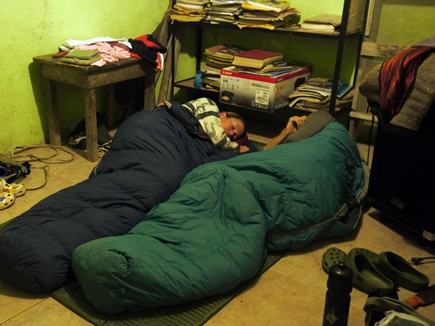
…and so when Maria offers us a spare room to roll out our mats, we are quick to accept.

The next morning the rain is still falling, and even the donkeys are refusing to budge. Gradually though, the downpour eases and we set off nervously, expecting a mud-bath…
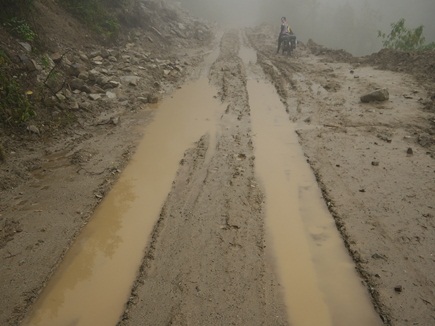
…and we're not disappointed. Luckily though, most of the route is still rideable…
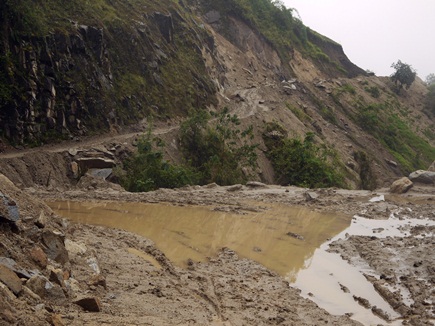
…give or take the odd minor landslide, which calls for a bit of push and shove. Somewhere under here, there is a track.
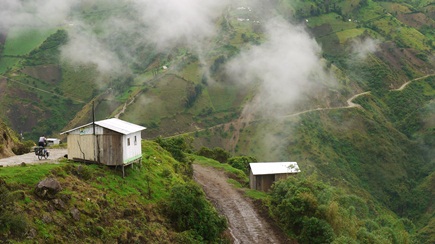
By mid-morning the clouds begin to disperse, breaking the misty bubble we have been riding in, and revealing the road snaking ahead, ever upwards.
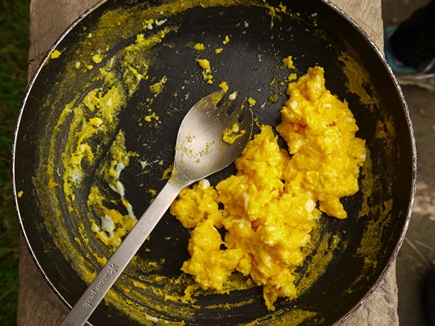
By Mindina, a calorie crisis is looming and we set about finding the village shop. It's dusty and half-empty, but with the stove on hand you can always rely on bread and eggs to plug the gap. Possibly the yellowest eggs I have ever eaten – somehow I think they may have been free-range.
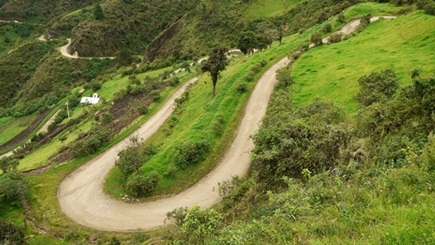
We had been warned that this leg to Simiátug had a sting in the tail, and so it proves. Some very thoughtful, very un-Ecuadorian switchbacks provide the warm up; followed by a far more typical, brutally steep and direct last few km into Simiátug.

The scenery as ever does its best to distract, as we crawl our way up through a beautiful lush valley peppered with wild flowers. Not for the first time in Ecuador, it feels like we had been transported back to Scotland or the Lake District.

Gourmet street food, Ecuadorian style. After days of fantasising about chips (our food fantasies go through these phases), we make it to Simiátug and Sarah finally gets to indulge. It definitely feels like we've earned them.

After a night snoring peacefully on the floor of the office of the Ministry of Agriculture (long story), we set out to explore Simiátug in the morning sunshine. It's a friendly, well-worn place – all ramshackle wooden balconies…
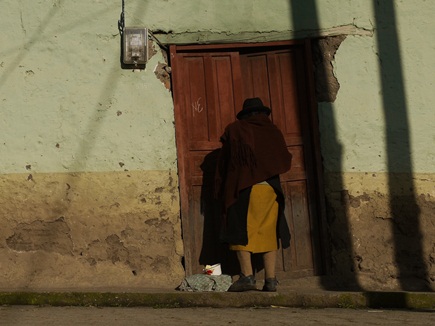
…peeling walls and intriguing doorways.
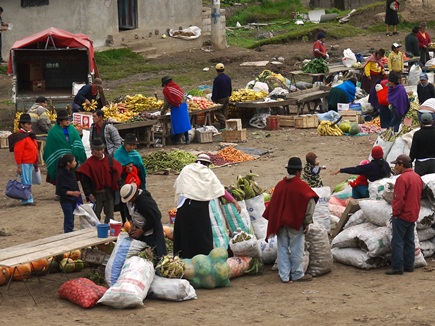
By pure luck, we've managed to coincide with the town's weekly market. It's by far the least touristy and most interesting we've seen so far – piles of fresh veg laid out on simple wooden tables…

…and the effortlessly cool Ecuadorian felt hats. Gringos need not apply.

Forget poncy cycle tourists, these guys are the real heroes of the Latin American cycling world. They spend all day every day hauling massive loads on their cargo bikes – and still manage a friendly grin.

We come across a guy who must be in his seventies struggling to push his bike loaded with chairs, tables and salted fish up the slope into the market place, and so I offer to lend a hand. Don't worry, I say, I've had a bit of practice at pushing heavy bikes up hills around here.

Back in the main square, the local volleyball tournament is in full swing as the mist rolls in. This seems to be Ecuador's national sport, with courts squeezed into flat spaces in even the most tiny of villages.

The next morning, we set off towards Chimborazo and Riobamba, hoping to make it in time for Easter. In accordance with Bolívar's First Law of Andean Town Placement, Simiatúg is conveniently nestled halfway up the mountainside – meaning that as well as a climb into the town, we are treated to a climb out of it as well…

…up towards the distant radio masts.

Even on rested legs, it's not easy, gaining 1,000m over just 14km into a vicious headwind…

…but by the top, we really are up above the clouds. At least, you'd think, we'd be rewarded with a decent descent…which we are – except it's cobbled. And so after 10km of truly unsatisfying, bone-rattling descent, we pop out onto the Vía Flores, feeling like we've just stepped out of a blender.
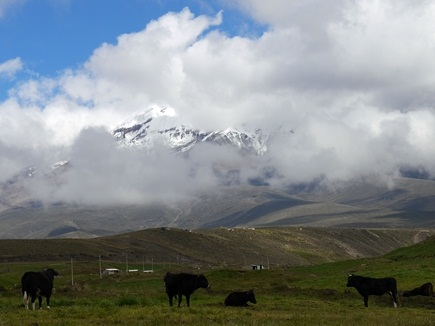
However, this is where we do get our reward – a first view of the snow-capped Volcán Chimborazo, the highest point in Ecuador's chain of volcanoes at 6,310m.

With time running short, we decide to take the paved loop around Chimborazo instead of the tempting dirt option through the middle. It turns out to be a good decision, as we are treated to spectacular views of the mountain in the evening light…
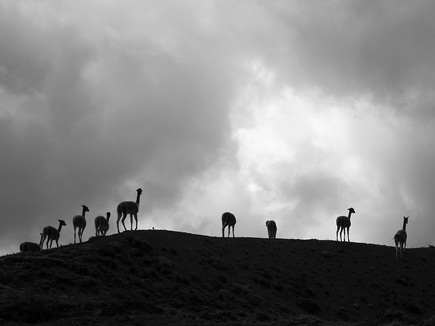
…with herds of beautiful vicuñas (a wild, more athletic type of llama) grazing on the lower slopes.
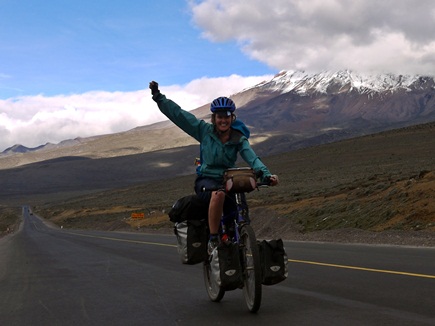
Surely we're allowed at least one cheesy “girl conquers volcano” shot, right? Go Bedders!

After probably our most freezing night to date sleeping in the half-constructed Chimborazo visitor centre at 4,350m, all that's left the next morning is an easy coast down towards Riobamba – but not before Chimborazo allows us a sneaky summit glimpse in the early morning light.
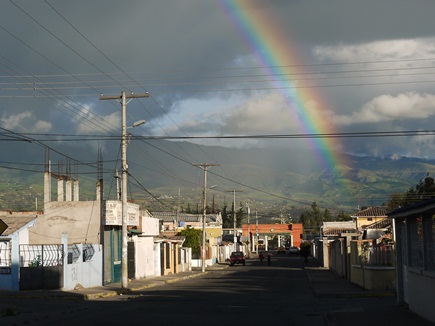
We roll into Riobamba on Good Friday, hoping to sample the traditional Ecuadorian Easter dish of fanesca – a soup made with 12 different grains and topped with cheese, salted fish and boiled egg. Within minutes of arriving, Ecuadorian hospitality strikes again – we are adopted by Ruperto, and spend a brilliant afternoon with his family of 40 sampling the fanesca they have spent the last two days preparing.
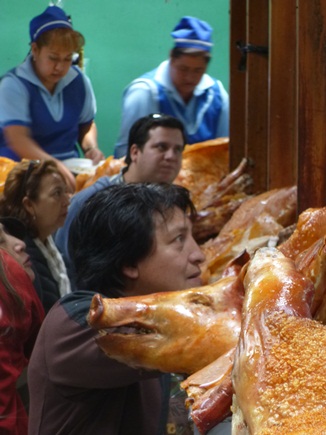
Appetites still raging, on Easter Sunday we head to the market to experience another Ecuadorian culinary tradition: chancho horneado, or roast pig. It's like a scene from a vegetarian horror film – imagine a room with wall-to-wall pig heads and parts, presided over by ladies in blue surgeons' uniforms wielding huge carving knives. Now I know what happens to all those roadside pigs – but it has to be said: the crackling is to die for.
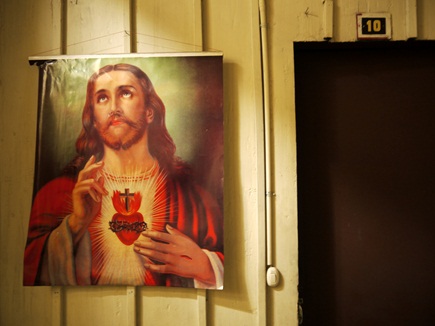
Finally sated, we head back to our characterful hotel room, which – in keeping with the Easter theme – is presided over by a beautifully coiffeured Jesus. “Please Lord,” he seemed to be saying…”Just spare them the cobbled descents.”
Route tips:
We used Cass Gilbert’s excellent route description in the Need to Know section of this blog post.
In Angamarca, we found out about a more direct up-and-over dirt route to Simiátug. This would have avoided the descent to Pinllopata and subsequent climb back up, but we were told that it would be pretty much impossible in wet season with heavily-loaded bikes. It sounded like it could be an interesting dry season alternative though.
We were also sorely tempted by Cass’s dirt route between Volcán Chimborazo and Carihuairazo, but in the end opted for the paved, more direct option into Riobamba. The cobbled descent from Simiátug drops you onto the Vía Flores (a paved, quieter road out of Ambato). Turn right and it’s about 10km to the main Ambato-Guaranda Road, where you can then pick up the loop road towards Riobamba. The first Chimborazo refugio is not at the park entrance as we thought – it’s another 8km of dirt uphill. Luckily, the guards allowed us to sleep in the half-finished new visitor centre, as we arrived just as it was getting dark. It looks like this visitor centre will also have accommodation eventually though.
Meeting the locals
April 14th, 2013
Much of the time atop my bike, shiny silver panniers gleaming in the sunlight, polystyrene helmet perched on my head, lycra rippling in the breeze, I feel more than a little stupid. We are travelling through rural areas, with backdrops of grass, mud, rivers, manure, trees, woven fabrics and farmyard animals…to say we stick out like sore thumbs is an understatement. If I was hoping to blend in, I’m not sure I thought through the colour scheme and fabric choices for my kit properly before we left the UK.
The routes we’ve chosen lately don’t see many long distance cycle tourists passing by. Riding through tiny indigenous villages, miles away from main roads, the sight of two gringos – on bicycles of all things – leaves many we pass with mouths wide open, pointing and shouting for relatives to come and take a look at the lycra-clad spectacle rolling past.
I sometimes wonder if I will be able to adjust to life after this trip when we are not being stared at. Intensely uncomfortable at the outset with being gawped at and crowded around, now I almost expect an audience when we park the bikes in a village and head to the local bakery.
Those who crowd ask hundreds of questions, the most common one being: “Why?”. Why would we want to cycle our bikes all the way down a continent just for pleasure? Saying that we have a passion for travel and a love of riding our bikes sounds so frivolous in comparison to the daily grind we encounter here. When we are talking to those we meet in the countryside, who are dragging their pigs to a patch of grass or walking with an incredibly heavy load on their backs, I want to lie and claim the trip is for something noble or important.
It’s often difficult to explain that we’ve come from the other side of the world to explore South America, when people we meet have often never visited their nearest big town, let alone their capital city. The best dollar we have spent in a long time was on a globe (travel-sized of course) to show people where in the world the UK is and the places we have travelled through on our journey so far. What amazes many is just how small the UK is; perhaps the name “Great” Britain makes many imagine a country as grand in physical size as its status in history.
Sometimes we don’t get chance to stop and chat; we go slowly and like to talk, but not so slowly that we can spend the whole day stopping to talk to everyone. In place of conversation, I try to make a point of at least smiling and saying good morning/afternoon to anyone within shouting distance. It’s amazing what a smile can do. A universal ice breaker, reassurance, a sign of peace, friendliness and solidarity. Many are visibly taken aback when they receive a smile from a stranger on a bike who has suddenly appeared in their familiar environment.
Yet the immediate and almost involuntary reaction of most is a smile back to me in return; that most basic of human interactions which transcends language and culture. I may seem alien, with spaceman panniers and a mushroom helmet, but smiling at each other bridges a thousand differences.
Sarah
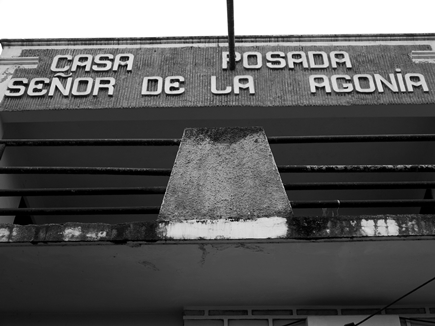
Leaving Riobamba with a bit of a false start: James has a dodgy stomach – perhaps an overdose of Easter eggs – and we cut short our day after just 20km in the small town of Punín. With no accommodation available, we ask at the nearby convent and the priest grants us permission to camp indoors at the aptly named Posada Señor de la Agonia or “Guesthouse of the Lord of Agony”.

We pass a series of Cuban-style billboards extolling the virtues of a newer, happier, Ecuador since President Correa has been in power. The link between national pride and the girl with a lamb is still unclear to me.
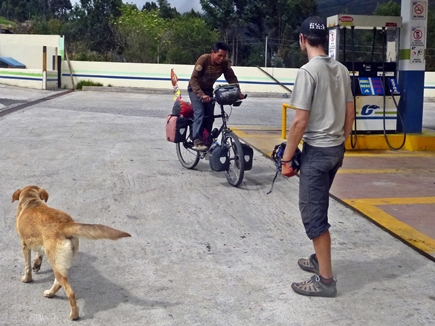
It's clear that this guy has had a dull morning when he jumps up and demands a test-ride of James' bike as we pull into the petrol station to fill up on fuel for our stove. James looks on anxiously as his baby is taken for a turn on the forecourt.
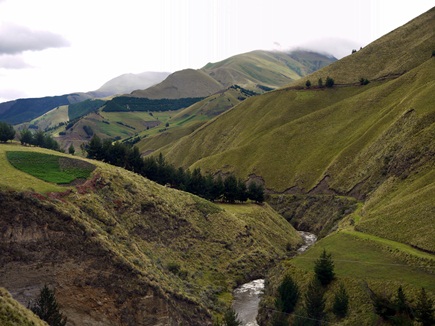
The ride to Lagunas de Atillo is beautiful, on a blissfully quiet paved road. We happily spend the day switching between waving and chatting to farmers and soaking up the wonderful rolling scenery.

I feel the estate agents' spiel would read something like: “Quaint country cottage with thatched roof, open fire and original features”.

The spaceman panniers look a little out place leaned against the wall of school at Punto Cero where we camped for the night…
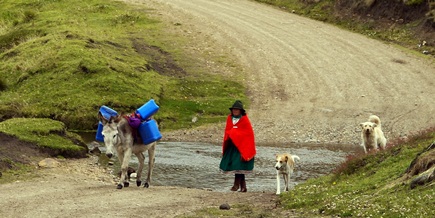
…but it does often bring you to places where seeing donkeys crossing rivers is more common than seeing a car.
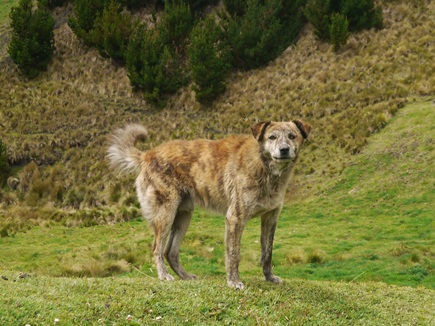
…but would rather see less of the vicious dogs. We're encountering more yappy and aggressive hounds here than anywhere else so far.

Camped on a manure pile (another first on our campsite list), we provide endless entertainment to Hector who lives nearby. He spends the evening running backwards and forwards delivering fruit to us from nearby bushes.
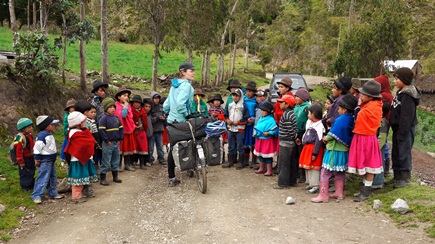
The following morning we waving goodbye to Hector, we ride straight into the middle of a group of inquisitive school kids. One is foolishly brave enough to ask about our trip…

…and out comes the globe for an impromptu geography lesson. I've never seen such an amazing collection of hats.
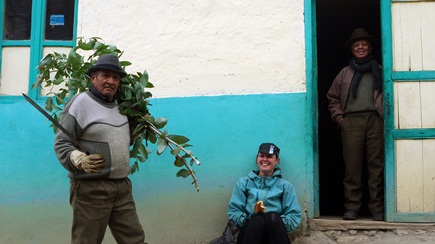
In Achupallas, a man with the machete insists we take his picture – and you don't disagree with a man carrying a machete.
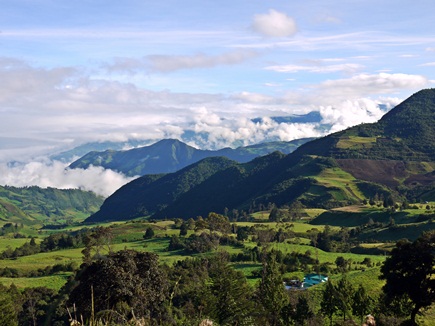
The thought of spending a day on the Pan American heading towards Cuenca was filling us with dread, but thankfully the traffic levels are not as heavy as anticipated – and the views are still as epic as out in the sticks.
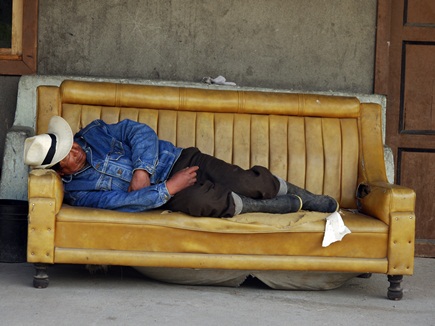
At 1030 in the morning, this fella is already enjoying the after effects of a session on the local firewater.
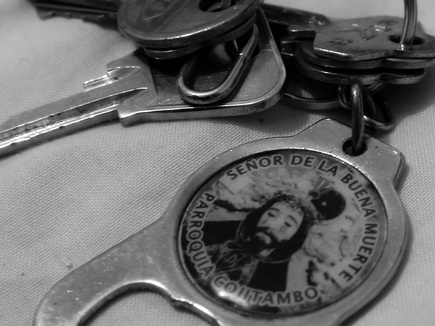
Just outside Cuenca we arrive in little Cojitambo after a long climb up as the sun is going down. We're fortunate to meet Natividad, a lady who runs a shop in the square. She promptly gives us a room to sleep in complete with our own set of keys; the keyring reads “Lord of the Good Death”…is there such a thing?
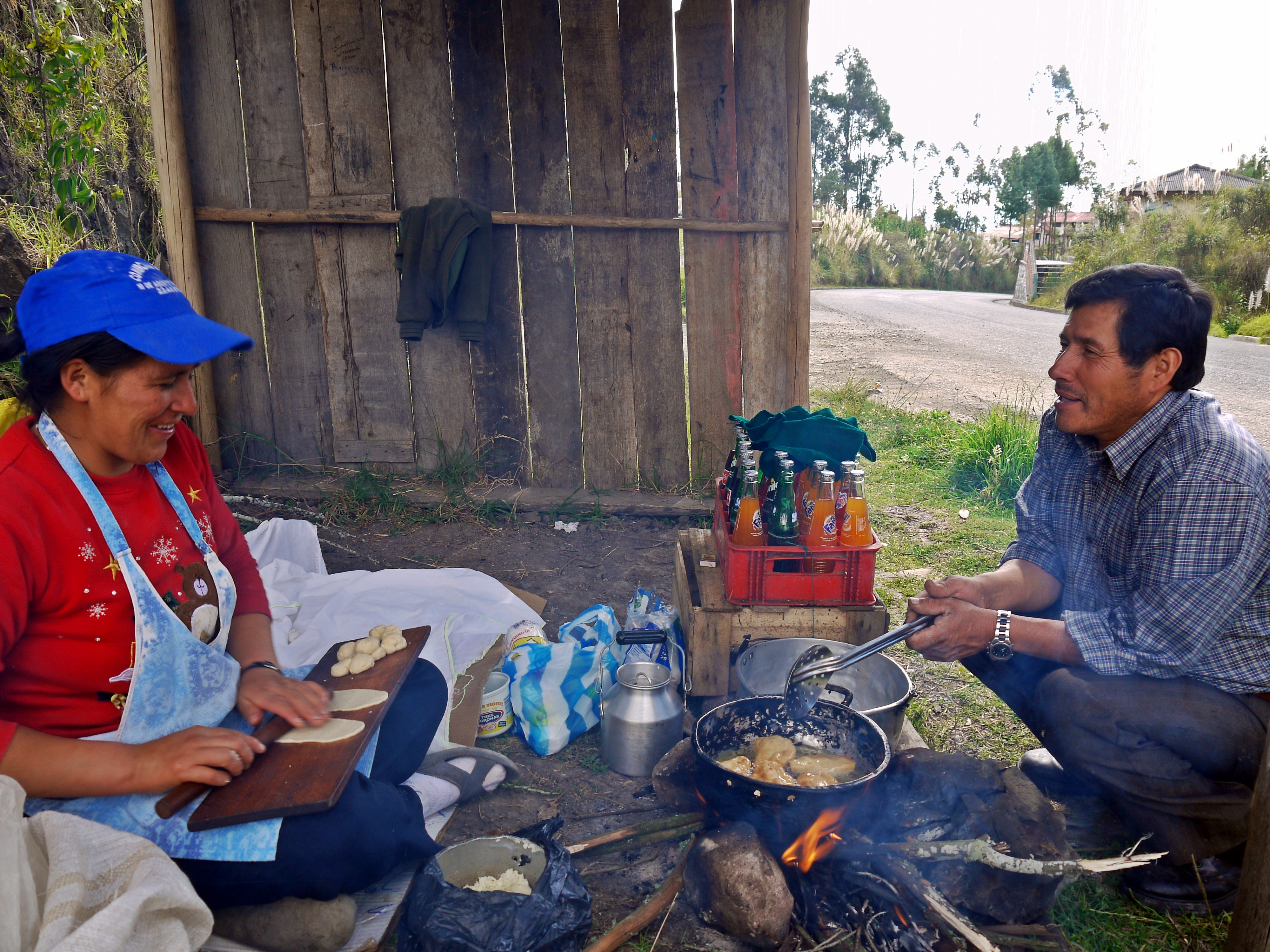
We can't resist making a final stop before Cuenca when we see Yolanda and Luis making empanadas over a wood fire by the roadside. Talk covers politics, geography, education and of course national cuisines. Soon two hours have passed by and we have eaten more than twenty of the delicious fritters. On a carb and sugar high, we ride the remaining 30km into the last major city in Ecuador.
Route tips:
We wanted to go from Riobamba to Cuenca, but without the 80km descent to Macas and subsequent climb back up into the sierra. Our compromise was to climb as far as the Lagunas de Atillo, before cutting west on some unmarked dirt roads to join the Pan American for a day into Cuenca.
The paved road from Riobamba to the Lagunas de Atillo was relatively traffic free with pretty countryside – around 100km. We then backtracked from Atillo to the junction at Punto Cero – 8km before the lakes – and headed towards Osogochi. There are a number of tracks around here so ask for Poca Totoras and Osogochi. From Punto Cero, it’s a 3km climb on dirt road followed by 7km on mud/dirt (a bit of pushing required if it has rained a lot) to reach Poca Totoras. From here, the road improves with 3km of good dirt bringing you to Osogochi.
It’s a 9km climb from Osogochi to reach a newly paved road – turn left to Totoras or right to the Pan American at Palmira. We chose left and after 5km went through Totoras (market day is Wednesday), before joining another good dirt road (beautiful ridge riding) for 26km to Achupallas.
From Achupallas there is a white-knuckle 15km descent to the Pan American at La Moya. From here you can take a right to Aluasí, or we went left to Chunchi – a further 20km. Our total distance from Punto Cero to Chunchi was 93km.
